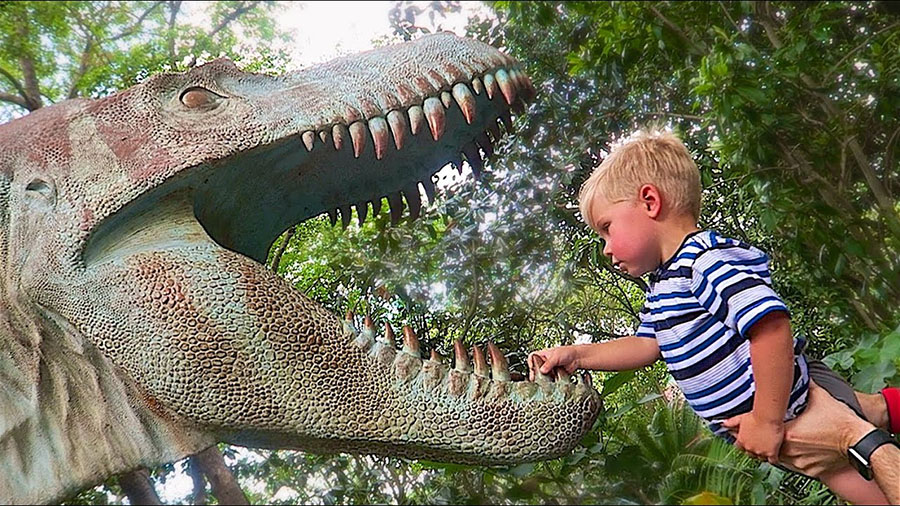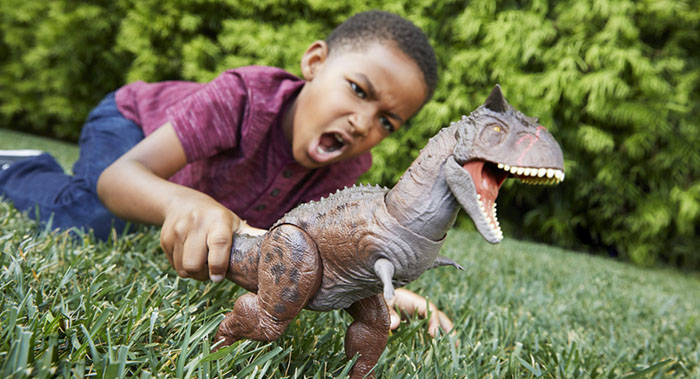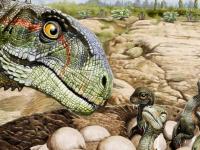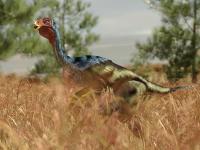Dinosaurs Are Colossal Beings That Shaped Our Childhood.

James Kirkland picked up his first dinosaur toy when he was 5 years old in 1959. He remembers it like it was yesterday.
Little did he know then that his love of dinosaurs would lead to a career as a paleontologist. Since the day his father brought home a special gift for him -- a toy dinosaur set -- after a business trip, Kirkland has spent nearly 50 years traveling the world unearthing fossils.
"Every time I find something new, it's just as exciting as the first time," said Kirkland, state paleontologist of Utah with the Utah Geological Survey.
Many children develop a love of dinosaurs at an early age, but most of the time, they don't become world-renowned paleontologists. Instead, it wanes, said Dr. Arthur Lavin, chair of the American Academy of Pediatrics committee on the Psychosocial Aspects of Child and Family Health.

Creating the 'self' through dinosaurs
Kids ages 3 to 4 go through a period of hyperfixation, which Lavin called "imagination-based play," where they become deeply interested in subjects like fairies, monsters, or in some cases, dinosaurs.
When babies are born, they aren't aware they exist for the first three months, he said. For the first year, there's no clearly defined sense of "self," Lavin noted.
At around 18 months old to 3 years old, children begin developing their sense of self but are still confused about the world around them, he said.
"It's why we call them the terrible twos because they know things aren't the way they want them, but they're not sure how they want them," or how to get them the way they want, Lavin said.
At age 3, they begin to master this sense that they're in the world, and they want to try out ideas, he said.
Children then embark on this journey of creating this thing called "self," and one of the ways they do that is to make up stuff in the world they've created, Lavin explained.
Dinosaurs fit into an imaginary play
Dinosaurs fit into their make-believe world because there aren't any alive today, so they're sort of like unicorns and fairies, he said.
"If you're going to have a make-believe world, which fits into this very powerful sense of developing a sense of self, dinosaurs really fit the bill," Lavin said.
Some children with a keen interest in the extinct animals can recite complicated dinosaur names and facts from memory, which was a pastime for Kirkland.
BIGGEST DINOSAUR MYTHS AND MYSTERIES
We've found all dinosaur species? Wrong. Scientists have definitively identified around 900 dinosaur species -- although there are plenty more where paleontologists don't quite have enough bones or the fossils aren't preserved enough to truly call them a unique species. Many, many more species existed - one estimate suggests that there were between 50,000 and 500,000, but we might never find their fossil remains. So many species could exist because they were highly specialized, meaning different types of dinosaurs had different sources of food and could live in the same habitats without competing. For example, with unusually large eyes and hair-trigger hearing, Shuuvia deserti, a tiny desert-dwelling dinosaur evolved to hunt at night.
We can tell what sex a dinosaur is? Wrong. On display at the Field Museum in Chicago, SUE the Tyrannosaurus rex is the world's most complete T. rex fossil but we don't know if it's male or female. Despite many earlier claims, including that female T. rexes were bigger than males, such findings are now are thought inconclusive. SUE is named for Sue Hendrickson, who discovered the dinosaur in 1990 during a commercial excavation trip north of Faith, South Dakota.
Dinosaurs were very different than humans? Yes and no. Dinosaurs suffered from some of the same diseases that afflict humans and animals today including cancer, gout and infections. T. rex was the ultimate dinosaur predator, but it fell victim to the tiniest of foes: parasites. The lower jaw of SUE the T. rex was pitted with smooth-edged holes -- a result of a parasitic infection called trichomonosis. It can also effect the lower jaw of modern birds like pigeons, doves and chickens.
Dinosaurs were all huge? Wrong. The first dinosaur discoveries, the earliest more than 150 years ago, focused on the sensational: The big bones and skulls we know from museum atriums. But dinosaurs came in all shapes and sizes. In fact, some of the most exciting finds in recent years have been tiny. In 2016, a tail, belonging to a sparrow-sized creature could have danced in the palm of your hand was found preserved in a chunk of amber.
Dinosaurs were scaly and reptilian? Wrong. New evidence has dramatically shifted the way see and perceive dinosaurs. While some dinosaurs did have reptilian scaly skin, many did not and were a lot more bird-like. Fossils showing primitive feathers were first unearthed in China in the mid-1990s. Now, it's widely accepted that many dinosaurs had fur or feathers. Yutyrannus, pictured in this illustration, is the largest feathered dinosaur discovered to date.
Dinosaurs were all greyish green? Wrong. Fossilized dinosaur feathers can reveal intriguing details about dinosaur coloring -- something once thought impossible. In some fossils, tiny structures called melanosomes that once contained pigment are preserved. By comparing the melanosomes with those of living birds, scientists can tell the possible original colors of the feathers. In the case of Sinosauropteryx, pictured here dark areas of the fossil were a rusty brown or ginger color and the rest were thought to be white.
We've found all dinosaur species? Wrong. Scientists have definitively identified around 900 dinosaur species -- although there are plenty more where paleontologists don't quite have enough bones or the fossils aren't preserved enough to truly call them a unique species. Many, many more species existed - one estimate suggests that there were between 50,000 and 500,000, but we might never find their fossil remains. So many species could exist because they were highly specialized, meaning different types of dinosaurs had different sources of food and could live in the same habitats without competing. For example, with unusually large eyes and hair-trigger hearing, Shuuvia deserti, a tiny desert-dwelling dinosaur evolved to hunt at night.
We can tell what sex a dinosaur is? Wrong. On display at the Field Museum in Chicago, SUE the Tyrannosaurus rex is the world's most complete T. rex fossil but we don't know if it's male or female. Despite many earlier claims, including that female T. rexes were bigger than males, such findings are now are thought inconclusive. SUE is named for Sue Hendrickson, who discovered the dinosaur in 1990 during a commercial excavation trip north of Faith, South Dakota.
Dinosaurs were very different than humans? Yes and no. Dinosaurs suffered from some of the same diseases that afflict humans and animals today including cancer, gout and infections. T. rex was the ultimate dinosaur predator, but it fell victim to the tiniest of foes: parasites. The lower jaw of SUE the T. rex was pitted with smooth-edged holes -- a result of a parasitic infection called trichomonosis. It can also effect the lower jaw of modern birds like pigeons, doves and chickens.
Dinosaurs were all huge? Wrong. The first dinosaur discoveries, the earliest more than 150 years ago, focused on the sensational: The big bones and skulls we know from museum atriums. But dinosaurs came in all shapes and sizes. In fact, some of the most exciting finds in recent years have been tiny. In 2016, a tail, belonging to a sparrow-sized creature could have danced in the palm of your hand was found preserved in a chunk of amber.
Dinosaurs were scaly and reptilian? Wrong. New evidence has dramatically shifted the way see and perceive dinosaurs. While some dinosaurs did have reptilian scaly skin, many did not and were a lot more bird-like. Fossils showing primitive feathers were first unearthed in China in the mid-1990s. Now, it's widely accepted that many dinosaurs had fur or feathers. Yutyrannus, pictured in this illustration, is the largest feathered dinosaur discovered to date.
Dinosaurs were all greyish green? Wrong. Fossilized dinosaur feathers can reveal intriguing details about dinosaur coloring -- something once thought impossible. In some fossils, tiny structures called melanosomes that once contained pigment are preserved. By comparing the melanosomes with those of living birds, scientists can tell the possible original colors of the feathers. In the case of Sinosauropteryx, pictured here dark areas of the fossil were a rusty brown or ginger color and the rest were thought to be white.

"I'd be going down the street, and a neighbor who's having a barbeque would call me over and say, 'You got to ask Jamie about dinosaurs,'" he said.
Learning advanced words at 3 and 4 years old is part of the natural development process, said Eli Lebowitz, associate professor in the Child Study Center at the Yale School of Medicine in New Haven, Connecticut.
While it might be a challenge for adults to remember the names of a dozen different dinosaur species, it's easier for young children because they're developing language skills and learning new words every day, he said.
The power of play
Playing as a young child is also extremely beneficial to a child's development and should be encouraged by adults in their life, according to the American Academy of Pediatrics.
Children who participate in playing see improvements in a variety of areas, including language, social development and early math skills.
Adults also benefit when they play with their child, according to the AAP research.
When adults engage in activities with their children, they can see the world through the eyes of a child and therefore communicate with children more effectively. Parents may also feel less stress from their parent-child relationship, the research found.
If parents have a child who loves dinosaurs, Lebowitz recommended they embrace the interest. Visit a dinosaur museum, read books about dinosaurs or explore a nearby park for fossils.
"Harness the child's interest as a launchpad for a whole lot of different kinds of experiences and learning, even into additional topics," Lebowitz said.
When reality sets in
Most children lose interest in dinosaurs and their make-believe world around ages 5 or 6, Lavin said.
The fantasy attraction of dinosaurs fades away, and children turn their attention to design a reality they want using the skills they learned while creating a make-believe one, he said.
Expanding social circles can also contribute to a decline in interest, Lebowitz said.
At 3 and 4 years old, children care about themselves and their immediate family, but as they grow, they become interested in others and how to get along with them, he said.
"While their parent may be patiently willing to talk about dinosaurs ad nauseum, it's very likely that other people will be less so," Lebowitz said.
The magic of dinosaurs fades for many, but not all, Lavin said.
"Some kids like the taste of that make-believe world of dinosaurs, and they never give it up," he said.
That can lead to research on how dinosaurs get sick (just like us), reproduce (not quite like us) and fly (definitely not like us). As Kirkland became an adult, his love of dinosaurs only grew stronger.
He currently promotes dinosaur tourism in Utah, helps regulate fossil excavations and works with other countries on identifying dinosaur bones.
"Understanding the history of our planet is very worthwhile, but getting kids interested in science is priceless," Kirkland said.
If your children are excited about dinosaurs, here are some resources to support their interest.
Dinosaur resources:
American Museum of Natural History -- Dinosaurs
American Museum of Natural History -- Paleontology for Kids
American Museum of Natural History -- Educational activities
Natural History Museum -- Dinosaur activities for families
Paleontology Education Resources compiled by Ashley Hall, outreach program manager at Museum of the Rockies in Bozeman, Montana.
Where to see fossils:
Dinosaur Ridge in Colorado
Dinosaur National Monument in Colorado and Utah
Cleveland Lloyd Dinosaur Quarry in Utah
Ashfall Fossil Beds State Historical Park in Nebraska
Calvert Cliffs State Park in Maryland
Siebel Dinosaur Complex in Montana
Berlin-Ichthyosaur State Park in Nevada
Ancient Odyssey -- join a paleontology dig at sites around the world
Source: https://edition.cnn.com/








